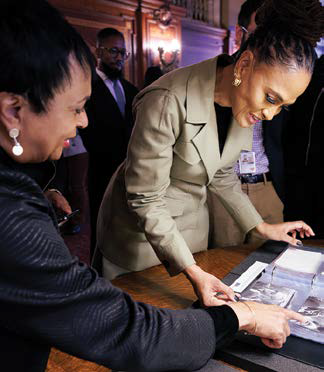LCM
LIBRARY OF CONGRESS MAGAZINE
MARCH/APRIL 2024
DAZZLING
DESIGN
The brilliant theater
costumes of Florence Klotz
Inside
Collection Helps Bring Bernstein to Silver Screen
Century of ‘Rhapsody’: A Masterpiece Hits 100
Plus
Ancestral Voices ‘Feeling Good,’
Still Jefferson’s Secret Code
FEATURES
6
10
20
Ancestral Voices
Project helps Native
peoples recover tribal
languages and culture.
‘Rhapsody’ at 100
The groundbreaking
work by George Gershwin
reaches the century mark.
A Maestro’s Life
Library collections helped
bring a sense of realism
to new Bernstein film.
▪ Thalia, one of the graces of Greek mythology, sits with her harp in this mural by Frank Weston Bensonin the Jefferson Building. Carol M. Highsmith Archive/Prints and Photographs Division
LCM
LIBRARY OF CONGRESS MAGAZINE
MARCH / APRIL 2024
VOL. 13 NO. 2
Mission of the
Library of Congress
The Library’s mission is to engage,
inspire and inform Congress
and the American people with a
universal and enduring source of
knowledge and creativity.
Library of Congress Magazine is
issued bimonthly by the Office of
Communications of the Library
of Congress and distributed
free of charge to publicly
supported libraries and research
institutions, donors, academic
libraries, learned societies and
allied organizations in the United
States. Research institutions and
educational organizations in other
countries may arrange to receive
Library of Congress Magazine on
an exchange basis by applying in
writing to the Library’s Director
for Acquisitions and Bibliographic
Access, 101 Independence Ave.
S.E., Washington DC 20540-
4100. LCM is also available on
the web at loc.gov/lcm/. All
other correspondence should
be addressed to the Office of
Communications, Library of
Congress, 101 Independence Ave.
S.E., Washington DC 20540-1610.
news@loc.gov
loc.gov/lcm
ISSN 2169-0855 (print)
ISSN 2169-0863 (online)
Carla Hayden
Librarian of Congress
April Slayton
Executive Editor
Mark Hartsell
Editor
Ashley Jones
Designer
Shawn Miller
Photo Editor
Contributors
Peter Armenti
Mark Horowitz
Elton John
Sahar Kazmi
Wendi A. Maloney
Kristin Phelps
Marianna Stell
Neely Tucker
CONNECT ON
▪ On the cover: Florence Klotz created this colorful costume design for “Pacific Overtures,” a 1976 musical by Stephen Sondheim set in 19th-century Japan. Florence Klotz Collection, Music Division; courtesy of Suzanne DeMarco
DEPARTMENTS
2 Extremes
4 Trending
5 Favorite Place
8 Off the Shelf
9 For You
18 Page from the Past
24 Around the Library
25 News Briefs
26 Shop the Library
27 Support the Library
28 Last Word




EXTREMES
▪ Right: Thomas Jefferson ordered an expedition to explore the newly acquired Louisiana Territory. Prints and Photographs Division
Opposite: Jefferson devised this grid of letters, numbers and symbols to encrypt messages for use by Meriwether Lewis (inset). The first of two versions of the cipher is shown here. Manuscript Division, Prints and Photographs Division
JEFFERSON'S SECRET CODE
He created this cipher for the
Lewis and Clark expedition.
In May 1804, Meriwether Lewis and William Clark set off into the great unknown of the Louisiana Territory, far from help and far from home. Ahead lay vast prairies, endless mountain ranges, uncharted streams, untold dangers.
Their mission: lead the Corps of Discovery across the continent, establish relations with Native peoples they met along the way, document plant and animal life and, most importantly, find a practical water route to the Pacific.
President Thomas Jefferson, who had ordered the expedition, expected no regular communication from the corps. But he did hope that traders or Natives might help get occasional messages back to Washington. Some of those communications, he believed, might contain sensitive information best kept secret.
Long fascinated by encryption, Jefferson devised a special cipher for use by the expedition and sent it to Lewis. Only they would understand any messages encoded with it.
“Avail yourself of these means to communicate to us, at seasonable intervals, a copy of your journal, notes & observations of every kind,” Jefferson wrote to Lewis on June 20, 1803, “putting into cypher whatever might do injury if betrayed.”
Two versions of the cipher, handwritten by the president, are preserved in the Jefferson papers held by the Library’s Manuscript Division. Both used grids of letters, numbers and symbols to encrypt and decode messages.

In the earlier version shown at right, Jefferson proposed two different methods to use the cipher, one employing a previously agreed-upon keyword to encode letters of the alphabet.
At the very bottom of the page, he provided an example: Jsfjwawpmfsxxiawprjjlxx zpwqxweudvsdmf&gmlibexpxu&izxpseer
Using the keyword “artichoke,” the incomprehensible string of letters and symbols reveals its hidden message: “I am at the head of the Missouri. All well, and the Indians so far friendly.”
Jefferson made a second, slightly revised version of the cipher and sent it to Lewis to carry west.
Lewis never found the opportunity to use the cipher, which today remains a curious relic of a bold mission across a wild continent.
—Mark Hartsell is editor of LCM.

